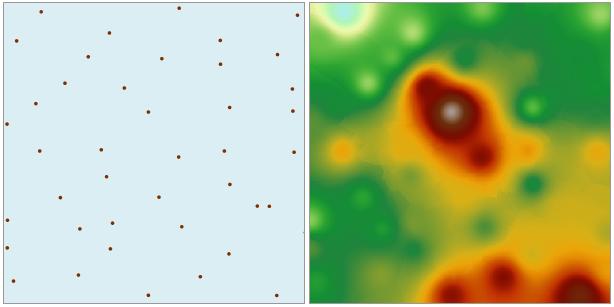Inverse Distance Weighted (IDW)
Feature Description
Inverse Distance Weighted interpolation estimates cell values by calculating the weighted average of neighboring sample points based on similarity within the interpolation area, ultimately generating a continuous surface.
- The source dataset must contain a numeric field as the interpolation field.
- IDW is a precise interpolation method suitable for sample datasets with uniform distribution and sufficient density to reflect local variations.
- IDW uses weighted average distances between sample points. The average value cannot exceed the maximum or minimum input values, ensuring all raster values in the output fall within the original sample data range.
- If known sample points lack local maxima (e.g., mountain peaks), interpolated values at potential maxima locations may be lower than surrounding points. Therefore, the sample dataset should ideally contain maximum and minimum values of the study area.

Parameter Description
| Parameter | Default Value | Description | Parameter Type |
|---|---|---|---|
| Source Dataset | Point dataset for interpolation analysis | DatasetVector | |
| Field | Numeric field representing values (elevation, precipitation, etc.) used in interpolation. Text fields are not supported. | String | |
| Scale Ratio | 1.0 | Scaling factor for interpolated values. Multiply source field values by this ratio before interpolation. Example: Ratio=2 produces raster values approximately twice those with ratio=1. Typically set to 1. | Double |
| Target Datasource | Datasource storing the result dataset | Datasource | |
| Result Dataset | Name of the output dataset | String | |
| Resolution | 0.0 | Spatial resolution of output raster, representing ground area per pixel. Unit matches dataset's coordinate system. | Double |
| Pixel Format | Storage format for raster pixels, including 1-bit unsigned, 16-bit, 32-bit, single-precision float, double-precision float. | PixelFormat | |
| No Value | 0.0 | Value representing missing data in the result dataset. | Double |
| Search Method | Point selection method for interpolation: Variable Length Search, Fixed Length Search, or Block Search. | SearchMode | |
| Expected Points (Optional) |
0 | Desired number of sample points for interpolation | Integer |
| Search Radius (Optional) |
0.0 | Radius for locating interpolation points | Double |
| Maximum Points (Optional) |
0 | Maximum points considered during block search | Integer |
| Max Points Per Block (Optional) |
0 | Maximum points per block during block search | Integer |
| Power | 0 | Exponent controlling distance weighting influence. Must be positive integer. Typically set to 2. | Integer |
| Output Bounds (Optional) |
Geographic extent for interpolation analysis | string |
Output
| Parameter | Description | Parameter Type |
|---|---|---|
| Result Dataset | Raster dataset generated by interpolation | DatasetGrid |



